Service Line:+86-022-82164980
Address:FL-4, Building A5, International Enterprise Community, Tianjin, China
Email:[email protected]
Introduction of THC
Tetrahydrocannabinol (THC), an organic compound with the chemical formula C21H30O2, is a chemical compound found in the cannabis plant and one of the main active ingredients in marijuana.THC produces relaxing and hallucinogenic effects, which help to improve mood, sleep quality, pain relief, anti-inflammatory, anti-cancer, anti-depression, and more. THC acts on substances in the brain called cannabinoid receptors, which regulate certain chemicals in the brain, such as serotonin and dopamine, to produce relaxation and hallucinatory effects.THC can also inhibit harmful excitatory substances, such as inflammatory substances, to reduce pain and improve mood. In addition, THC can inhibit the growth of cancer cells and reduce the incidence of cancer.
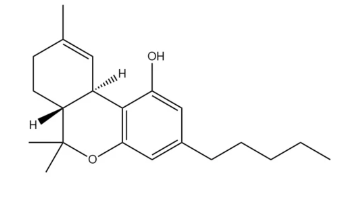
Figure 1 THC structural formula
Introduction to 6-MAM
Specific Detector of Heroin Abuse - 6-Monoacetylmorphine
Opioids mainly include morphine, heroin, codeine, and other opioid alkaloids, whose common metabolite in the body is morphine, and other metabolites include desomorphine, the sulfate of desomorphine-3-ether, morphine-3,6-diglucuronide, and so on. 6-monoacetylmorphine (6-MAM, also known as 6-monoacetylmorphine, or 6-AM) is one of the three heroin active metabolites one of them (diacetylmorphine), the others being morphine and morphine-6-glucuronide. Heroin forms 6-AM rapidly in the body and is then either metabolized to morphine or excreted in the urine. Because 6-AM is a specific metabolite for heroin, the identification of 6-AM is considered clear evidence of heroin use.
Heroin is metabolized rapidly in the body, with a blood half-life of only 3-9 minutes, and is hydrolyzed in the body by esterases to 6-monoacetylmorphine (6-monoacetylmorphine/6-acetylmorphine, 6-MAM /6-AM), also known as O6-monoacetylmorphine. Because morphine and codeine cannot be acetylated in the body to form 6-monoacetylmorphine, which is contained in the metabolites of heroin, the U.S. Department of Health and Human Services (DHHS) has recommended that 6-monoacetylmorphine be used as a specific test for heroin abuse. 6-monoacetylmorphine has a half-life of about 35 minutes in the body, and is then rapidly metabolized to morphine. 6-monoacetylmorphine is generally detectable in the urine of heroin abusers within 24 hours, with the optimal detection time being 2-8 hours after abuse. In addition, studies have shown that the longer the duration of heroin abuse, the greater the amount abused, and the shorter the interval between the last abuse and the urine test, the greater the likelihood of detecting heroin or 6-monoacetylmorphine.
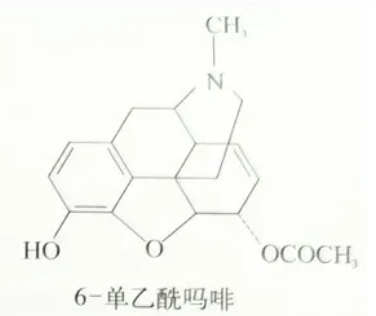
Figure 2 Structural formula of 6-MAM
Introduction to TRA
Tramadol (TRA) is gradually replacing high-affinity opioids in acute and chronic pain management worldwide.
TRA is a synthetic codeine analog. It affects nociceptive transmission by inhibiting norepinephrine reuptake at neuronal synapses and increasing extra-neuronal 5-hydroxytryptamine concentrations.
Tramadol is the first opioid discovered to have a dual analgesic effect, as an opioid agonist with a weak affinity for the mu receptor, and as an analgesic by inhibiting the reuptake of 5-hydroxytryptamine (5-HT) and norepinephrine (NE), which affects nociceptive transmission. Tramadol is a racemic mixture, the [+] enantiomer has a stronger inhibitory effect on 5-HT reuptake, while the [-] enantiomer has a stronger inhibitory effect on NE reuptake. Strength is 1/10~1/8 of morphine, no respiratory inhibition, small dependence, significant analgesic effect. Tramadol is metabolized in the liver, and 80% of it is excreted in the urine in its original form and metabolites within 24 hours.
Tramadol is metabolized by CYP2D6 and CYP3A4 in the hepatic cytochrome P450 family to produce three main products (M1, M2, M5), of which M1 and M5 are active.
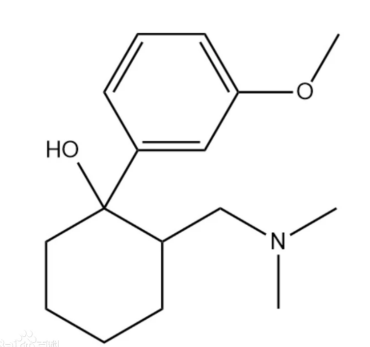
Figure 3 TRA structural formula
Introduction of CAF
Caffeine (CAF) is a methylxanthine alkaloid. Caffeine is a very drug-like molecule that conforms to the "rule of five", is moderately lipophilic (experimental logP -0.01, logP -0.07 also reported), and can pass through biological membranes/barriers. Caffeine is readily soluble in water (21.7 g/L) and has a pronounced temperature-dependent solubility (66 g/L in boiling water). All atoms of the bicyclic system are sp2 hybridized, making the xanthine structure a flat backbone structure
The optimal molecular activity of caffeine is antagonism of all subtypes of adenosine receptors with IC50 values in the 10 μM range. When adenosine binds to adenosine receptor proteins on the cell membrane, signaling for sleepiness is communicated in the cell. This signaling mechanism, however, is not created when the adenosine receptor is competitively bound by caffeine, resulting in a rejuvenating wakefulness. Adenosine receptor antagonism is thought to mediate most of the known biological effects of caffeine in humans, including analgesic adjuvant activity and neuroprotective properties. Caffeine is also thought to be involved in carcinogenesis, although the concentrations used in the laboratory to influence cell cycle and apoptosis may be uncommon in vivo.
The metabolism of caffeine occurs in the liver, where it is oxidized by the cytochrome oxidase P450 (specifically the 1A2 isoform) enzyme system to form three different dimethylxanthines, paraxanthine (84%), theobromine (12%), AND theophylline (4%) Caffeine is completely absorbed by the stomach and small intestine within 45 minutes of ingestion. It is disseminated to all organs of the body after absorption, and the conversion mechanism is compatible with a chemodynamic first order reaction.
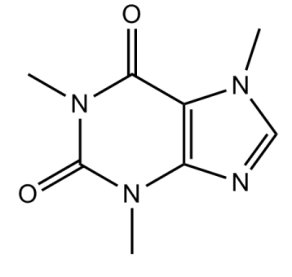
Figure 4 Structural formula of CAF
Introduction to BUP
Buprenorphine (BUP), an organic compound with the chemical formula C29H41NO4, is an opioid receptor partial agonist and is classified as a Class I psychotropic substance. The analgesic effect is stronger than pethidine. Slow onset of action and long duration. It has inhibitory effect on respiration, but serious respiratory depression has not been seen in the clinic. Drug addiction is similar to morphine addiction. . Good absorption after injection, can pass the placenta and blood-brain barrier, metabolized in the liver, excreted by bile and feces. Mainly used for all kinds of postoperative pain relief, cancer pain, burns, limb pain, angina, etc.The action will last 6-8 hours.
BUP is a semi-synthetic derivative of Tibaine, a partial agonist of the μ receptor. . Compared to morphine, the analgesic impact is stronger, but it takes longer to start working. . It is used clinically for pain after cancer, surgery, burns and myocardial infarction. Due to its long duration of action, low somatic dependence and mild withdrawal symptoms, it is an important alternative drug for detoxification treatment of opioid addicts, and is used for detoxification, with effects similar to those of methadone. Common adverse responses include nausea, vomiting,dizziness,and drowsiness.
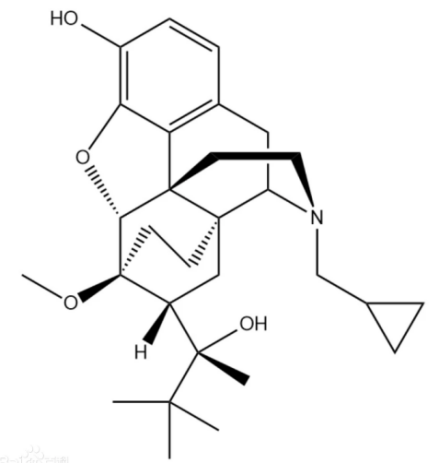 |
Figure 5 Structural formula of BUP
KMD Bioscience has an excellent in vitro diagnostic reagent development platform, all raw materials have been repeatedly verified by multiple application platforms, and under strict production process control, we can continuously and stably provide high-quality raw materials for our IVD customers.
KMD Bioscience can provide a list of reagents related to drug testing:
|
CAT# |
Product Name |
Species |
Host |
Application |
Size |
|
SMAG3312 |
Human |
|
LFIA (Lateral-Flow Immunochromatographic Assay), CLIA (Chemiluminescence Immunoassay), ELISA |
1mg |
|
|
SMAG3313 |
Human |
|
ELISA, Immunochromatography |
1mg |
|
|
SMAG3314 |
Human |
|
LFIA (Lateral-Flow Immunochromatographic Assay), CLIA (Chemiluminescence Immunoassay), ELISA |
1mg |
|
|
SMAG3315 |
|
|
LFIA (Lateral-Flow Immunochromatographic Assay), CLIA (Chemiluminescence Immunoassay), ELISA |
1mg |
|
|
SMAG3282 |
Human |
E. coli |
LFIA (Lateral-Flow Immunochromatographic Assay), CLIA (Chemiluminescence Immunoassay), ELISA, Quality Control |
1mg |
|
|
SMAG3283 |
Recombinant Human Treponema pallidum (TP) Protein (Detection) |
Human |
E. coli |
LFIA (Lateral-Flow Immunochromatographic Assay), CLIA (Chemiluminescence Immunoassay), ELISA, Quality Control |
1mg |